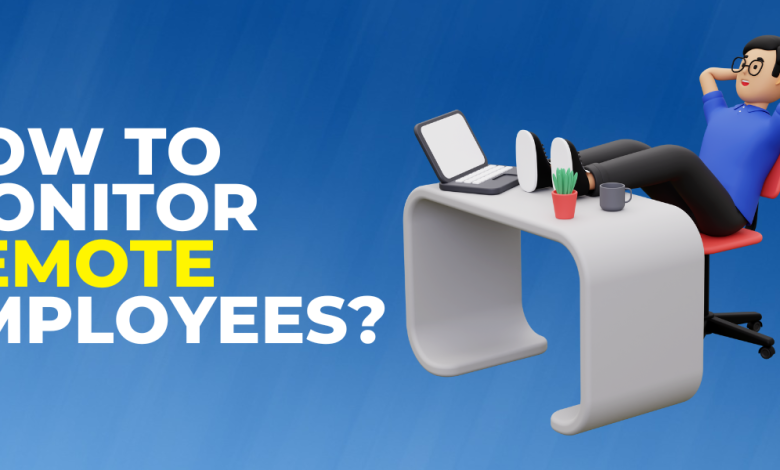How To Monitor Remote Employees?

The pandemic forced many people to work from home, and businesses relied on employee data to maintain track of their workforces.
You (as a business owner/manager) can access almost everything your employees do electronically, and monitoring software makes data collection and analysis simple.
As work-from-home has been the new standard since the epidemic, the reliance on employee tracking has grown.
Employers can collect data from the employee’s keyboard, such as how frequently they type, and even their webcam, provided the employment agreement allows it.
An employer can likely see which websites an employee visits and read the emails they send from company accounts when using corporate Internet connections.
Companies that create software that analyses the data generated by employees during the workday are doing well.
These programmes provide reports to managers on how frequently employees type when they log off and on, as well as which social media sites they visit.
Eventually, in this article, we will try to explain the methods or ways from which You can track your remote employees and get the best out of them.
So if you’re an employer and want to track the activities your employees are doing then this article is for you.
Check Employee Email Activities
A modern professional spends a significant portion of their workday in their inbox. That’s a lot of emailing time.
You, however, must be aware that their employees are spending time in their email inboxes. You must be aware of what is going on at the time.
Who are they sending emails to?
What number of emails did they send and receive today? What is their response time to new leads or customers?
Email is a good indicator of how much work someone is doing at any particular time.
The more emails someone sends and receives, the busier they are.
If you want to see your employees’ email activity, you’ll need a platform that allows you to keep track of their mailing activities.
Such solutions sync with your employees’ email accounts, allowing you to see how many emails they send and receive, who their top senders and recipients are, when they are busiest during the day and week, typical email response times, and much more.
It allows you to immediately understand who on your team is the busiest, who isn’t contributing, and how you may re-balance responsibilities to maximise productivity and efficiency.
This is the very first way to see if the remote employees are actually at their desks or not.
Use Employee Monitoring Softwares
The next and one of the best options is to use an employee productivity monitoring tool to monitor how your staff use their time throughout the day.
Remote employee monitoring software is a monitoring software that is used to manage the performance of remote employees.
Businesses who wish to boost remote employee engagement, uncover productivity bottlenecks, and understand how their remote workforce operates can use these solutions.
These remote monitoring software solutions can track a wide range of employee computer activity.
They also allow you to separate employee computer usage statistics by individuals, devices, and workgroups so you can get the most out of the data collected.
This software allows administrators to define distinct rules and regulations for different members of the organization, as well as get notifications when employees disobey the company’s acceptable use policy.
They come in a variety of versions, but they all serve the same purpose: to help you track and manage remote employees.
You can log in at any time to see which employees are assigned to which projects and if any employees require more activities to fill their day.
We recommend that you look into Workforce Next’s field employee tracking software to track the workforce of remote employees, as they are more than just regular software and have a lot more to offer.
They also provide you with a 7-day free trial so that you can explore the software and then purchase it only if it satisfies your needs.
The software can automatically track the location and time of employees and determine the path they took in a given timeframe.
Below are some features the software comes with.
- Attendance & Location Tracking
- Geo-fencing and notifications
- Track time at location
- Capture Photographs
- Task Management and Scheduling
- Tracking in real time
- Upload bills
- Offline data storage
- Save phone power
Benefits of an Employee Tracking Software
Control over remote employees – It is obvious that remote workers require control just as much as office workers, if not more.
So, an employee should just install an agent application on his computer, and you will have access to the same exact information about all of his work.
Managers no longer need to check the status of any project or ask their staff whatever task they are working on because the activity time tracking function automatically shows the activities performed,
allowing them to readily depict the progress of work. Everything could be accessed in real-time from anywhere and at any time.
Proper Attendance – There are numerous factors that affect an employee’s attendance, including off time schedule, start time schedule, arrival time, leaves, break periods, and so on.
Aside from that, hourly work attendance is critical for evaluating an employee’s performance.
When various employees are remote or working from home, tracking attendance becomes a significant hassle. Thus, in order to schedule employee leave in advance,
it is critical to track attendance using a reliable system. This kind of softwares help you in taking the attendance of the employees as well as efficiently.
Increase in productivity – In the absence of an employee monitoring system, managers will have no idea where all of their employees are because one person cannot keep track of hundreds of employees.
There is little doubt that when employees know that their every action is being watched by their bosses, they waste less time and focus more on their work.
They will not be distracted by insignificant office gossip or personal tasks.
In this way, the overall productivity of the business can be enhanced.
Create Task Lists
To maintain a competent workforce, the next is to develop a task or to-do list for the employees and ask them to follow it willingly.
Task lists can be useful in project management since they focus on specific tasks assigned to people rather than high-level initiatives.
There are usually two types of employees in your remote team: dedicated employees who complete their assignments on schedule, and those that work solely for the purpose of working.
If you wish to overcome this casual attitude among employees, assign duties to project team members with due dates and regular follow-ups.
This technique could help because when employees take ownership of their responsibilities, they perform effectively and strive to complete them on time.
You simply need to express your expectations to your staff and seek input from them on a regular basis.
It will build trust among your employees and keep them engaged and focused on the same goal.
Conclusion
When an employee enters or leaves Location information, the system sends a notification, i.e. verified automatic site attendance.
It also tracks when an employee arrives at a location and logs how long he stays there.
It also determines how much time employees spend on projects and related tasks so that managers can analyze their projects.
If a manager or administrator wishes to check an employee’s location, they only need to click a button to see the employee’s location in real-time on a map.
If you are looking to manage and track remote employees and their workforce, you can put a tick mark on the above techniques mentioned.
And don’t forget to checkout Workforce Next’s fieldforce tracking software’s free trial.





